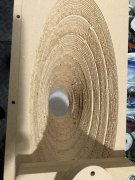Lee,
High performance audio by audio enthusiasts is a little different game than the
'audiophiles' tweaking their well-behaved mini-monitors. From what I can tell, a pair of those speakers being driven by a Class A amp (or SET?) are never going to dynamically pull on an AC circuit like we can & do on a regular basis.
It's like getting into a conversation about how to best tame wheel hop on an old big block muscle car, and the people sitting around you that drive Toyota Prius's have no idea what wheel hop is...or how violent it can be.
But not to worry -- someday, just like NeverSatisfied, I won't be pre-occupied with all this junque -- I'll just be listening to the music in my newly renovated audio decompression chamber. I won't even look at the RCA line meter...that often. :0)
Cheers --





